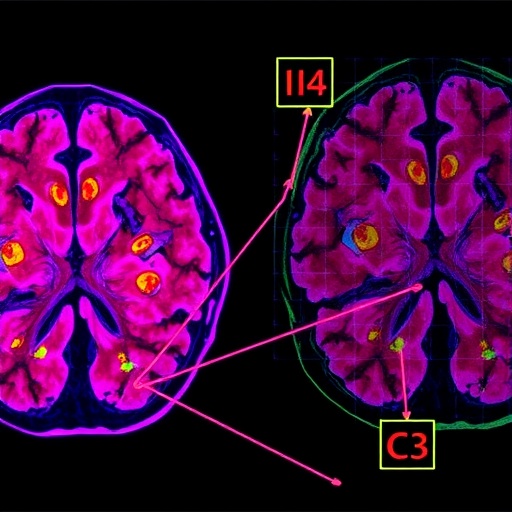Recent studies in the field of oncology have shed light on the complexities of glioblastoma, a highly aggressive brain tumor characterized by its rapid progression and poor prognosis. A breakthrough research article published in BMC Neuroscience highlights the role of Shikonin, a bioactive compound derived from the root of Lithospermum erythrorhizon, in the inhibition of epithelial-mesenchymal transition (EMT) in glioblastoma cells. The study conducted by Zhang, Liu, and Wang et al. provides compelling evidence of how Shikonin exerts its anticancer effects by modulating the p53 signaling pathway and enhancing levels of the microRNA miR-361-5p, which collectively work to suppress the expression of ZEB1, a known promoter of EMT.
Epithelial-mesenchymal transition is a crucial biological process during cancer progression, significantly contributing to tumor invasiveness and metastasis. In this study, the authors detail how the induction of EMT facilitates the transition of adherent epithelial cells into migratory mesenchymal cells, subsequently promoting cancer cells’ ability to invade surrounding tissues. Specifically in glioblastoma, this transition is rampant and correlates with increased malignancy.
Shikonin’s mechanisms of action begin with its effects on the p53 tumor suppressor protein, a key regulator of cell cycle and apoptosis. The authors report that Shikonin elevates p53 expression, which plays a pivotal role in preventing cancer cell proliferation and survival. Enhanced levels of p53 activate downstream targets that induce apoptosis and inhibit cell growth, making it a potent agent against tumor growth.
In addition to p53, this study highlights the significance of miR-361-5p in mediating Shikonin’s anti-tumor effects. MicroRNAs are small, non-coding RNAs that regulate gene expression at the post-transcriptional level. The upregulation of miR-361-5p in glioblastoma cells treated with Shikonin leads to the suppression of ZEB1, a transcription factor fundamentally involved in promoting EMT. By reducing ZEB1 levels, Shikonin effectively removes the impetus for EMT, thereby hindering the potent migratory and invasive capabilities of glioblastoma cells.
Interestingly, the study utilizes multiple experimental approaches to confirm Shikonin’s effectiveness. The researchers employed in vitro assays with various glioblastoma cell lines to assess cell viability, migration, and invasion. In tandem, they utilized Western blot analysis and quantitative RT-PCR to measure the expressions of p53, miR-361-5p, and ZEB1, establishing a clear biochemical pathway influenced by Shikonin.
The implications of this research are monumental, providing a scientific basis for utilizing Shikonin as a viable therapeutic strategy against glioblastoma. The findings emphasize not only the potential for Shikonin as a standalone treatment but also suggest its possible integration into combination therapies, where traditional chemotherapeutic agents could be used alongside natural compounds like Shikonin.
Furthermore, the study contextualizes the significance of deriving therapies from natural products. With increasing resistance to conventional chemotherapy agents, natural compounds like Shikonin present alternative routes for treatment development. These substances often possess multi-targeted mechanisms that can effectively tackle the heterogeneous nature of tumors, such as glioblastoma.
Building on this premise, the study invites additional investigation into Shikonin’s role with other oncogenic pathways, particularly those associated with tumor microenvironments and interactions with immune responses. A comprehensive understanding of these interactions could illuminate novel therapeutic avenues that could enhance the efficacy of glioblastoma treatment protocols.
As research continues, the potential for translational applications derived from this study becomes clearer. Future clinical trials are essential to validate the safety and efficacy of Shikonin in human subjects. If successful, Shikonin could become a cornerstone in novel therapeutic regimens for glioblastoma, ultimately improving patient outcomes.
The science community eagerly anticipates further studies that address the challenges of translating these findings into clinical practice. As this research gains traction, it sets the stage for an exciting period of innovation in glioblastoma therapy, where traditional knowledge intersects with cutting-edge science.
In conclusion, the exploration of Shikonin and its effects on glioblastoma provides not just hope for those affected by this disease, but also emphasizes the shared role of natural products in cancer pharmacology. As researchers delve deeper into the cellular mechanisms associated with EMT, p53, miR-361-5p, and ZEB1, a clearer picture of how to combat glioblastoma will emerge, offering a brighter future for patients and their families.
In light of this research, it is evident that unearthing the complexities of glioblastoma requires a multi-faceted approach. The work by Zhang, Liu, and Wang et al. stands as a pivotal contribution to our understanding, one that may pave the way for future breakthroughs in the fight against one of the most challenging cancers.
Subject of Research: Glioblastoma and the effects of Shikonin on epithelial-mesenchymal transition.
Article Title: Shikonin inhibits epithelial-mesenchymal transition in glioblastoma cells by upregulating p53 and promoting miR-361-5p level to suppress ZEB1 expression.
Article References:
Zhang, F., Liu, Z., Wang, Y. et al. Shikonin inhibits epithelial-mesenchymal transition in glioblastoma cells by upregulating p53 and promoting miR-361-5p level to suppress ZEB1 expression.
BMC Neurosci 26, 37 (2025). https://doi.org/10.1186/s12868-025-00956-6
Image Credits: AI Generated
DOI: 10.1186/s12868-025-00956-6
Keywords: glioblastoma, Shikonin, epithelial-mesenchymal transition, p53, miR-361-5p, ZEB1, cancer therapy.




